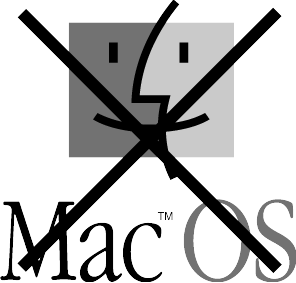



Once upon a time, when Apple Computer, Inc., wanted to turn the Macintosh into a ubiquitous, "generic" computer, the company created Mac OS. Since the very beginning, Macintosh operating systems were called "System somethingorother," but after System 7.5.3, Apple decided the operating system should be known as Mac OS, and a suitably generic logo, without the trademark apple and without any of the usual Apple corporate colors, came into being.
The Mac OS logo was useful: for the first time, Macintosh users had a name for their operating system. Macintosh clone makers liked the name and the logo, since the new operating system put up a nice, friendly blue, black and white "splash screen" featuring one, two or three smiling faces, depending on how you looked at it. Unlike Microsoft's Windows logo, the clone makers also liked the fact that the Mac OS logo didn't have the name of another company greeting the user at every boot. Everything was sunny and bright.
Until Steve Jobs, a non-Apple employee, engineered a palace coup, toppled the Apple management, and wiped out the Macintosh clone market. The "new" Apple quickly went through several operating system marketing schemes that made no sense to anyone outside of Apple. Finally, in 1998, Apple decided that the future would bring two and a half Apple operating systems: Mac OS, Mac OS X [Ten], and Mac OS X Server [the "half" part].
Mac OS, in the form of Mac OS 8, 8.1, 8.5 and 8.5.1, has proven to be a strong, resilient foundation for the "new" Apple, fueling a wave of new PowerBooks plus the colorful iMac and "blue and white" Power Mac G3 systems. Things got a bit more interesting with the early 1999 release of Mac OS X; despite the apparent similarity between "Mac OS" and "Mac OS X," the latter -- a variant of UNIX -- is not even remotely related to the former.
Apparently Apple agrees, for in early 1999 Apple released a set of new guidelines and licenses for developers:
Out: the Mac OS logo
In: a simplified variant of the former logo, in both vertical and horizontal versions, with just the word "Mac."
 |

|
|
Out: the beloved, friendly Mac OS logo. |
In: the new, simplified "Mac" logo, in convenient horizontal and vertical orientations. The new logo retains the blue, black and white coloring of the Mac OS logo. |
The new guidelines even have diagrams showing how the new logo can be placed on software packages. This ever so helpful document doesn't even mention one big benefit: the new logo can be used for either Mac OS or for the new Mac OS X.
About the same time, however, Apple also released guidance to developers, user groups and "partners" on the use of logos on Web sites. The legal elements remind all parties that the Apple logo belongs to Apple, and can't be used by anyone else without Apple's permission. But "guidance" included with the legal language suggests how developers, user groups and "partners" can "enhance" their Web sites with a new, nice, color banner showing a Mac OS box, an Apple corporate apple, and the phrase, "Works best with Mac OS 8.5."
|
|
|
Still in: while not authorized for hardware or software packaging, Apple does encourage developers, user groups and "partners" to use this logo on their Web sites. |
Mac OS is dead. Long live Mac OS.
![]()
Revised April 11, 1999 Lawrence I. Charters
Washington Apple Pi
URL: http://www.wap.org/journal/